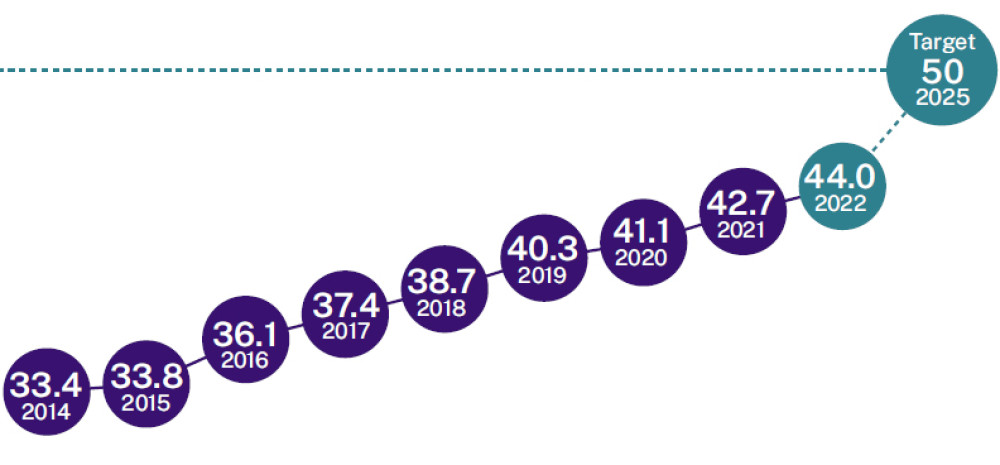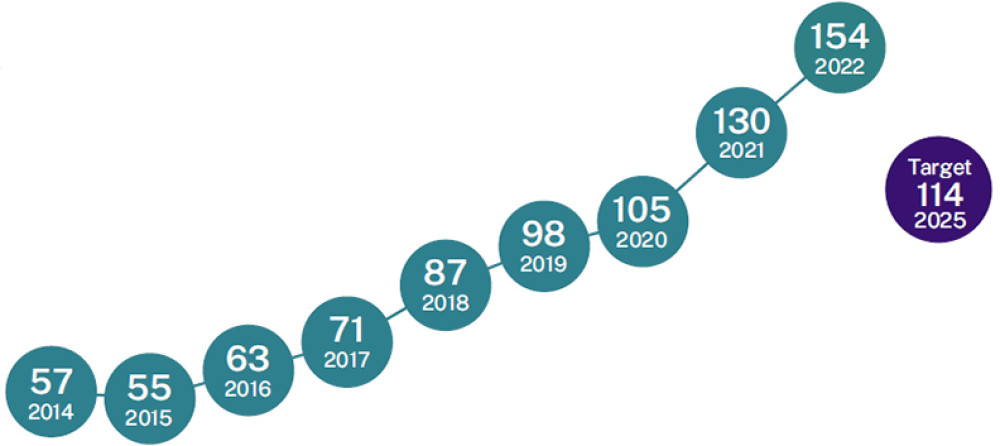4,059
senior executives in the government sector
+10.3pp vs 2021
Note: ‘pp’ stands for percentage points.
A key objective of the Government Sector Employment Act 2013 was to create a simpler executive structure that gives this cohort greater mobility across the sector. The Government Sector Employment Legislation Amendment Act 2016 supported this by aligning the senior executive employment arrangements of the NSW Health Service, Transport Service and NSW Police Force with those of the Public Service.
Table 3.1: Senior executives in the public sector, census headcount, 2021 to 2022
| Service | 2021 | 2022 | Change (%) |
|---|---|---|---|
| Public Service | 2,280 | 2,484 | 8.9 |
| NSW Health Service | 200 | 198 | -1.0 |
| NSW Police Force | 74 | 67 | -9.5 |
| Teaching Service | 0 | 0 | 0.0 |
| Transport Service | 854 | 1,083 | 26.8 |
| Other Crown services | 272 | 227 | -16.5 |
| Total government sector | 3,680 | 4,059 | 10.3 |
| State owned corporations1 | 281 | 402 | 43.1 |
| External to government sector | 58 | 62 | 6.9 |
| Total public sector | 4,019 | 4,523 | 12.5 |
At June 2022, there were 4,523 senior executives in the public sector. Of these, 4,059 were in the government sector, which was a 10.3% increase compared to the previous year.
The largest increases in the government sector occurred in the Transport Service (+229, 26.8%) and the Public Service (+204, 8.9%). The number of senior executives increased by 168 at Transport for NSW and 66 at Sydney Metro, compared to 2021.
There were 2,484 senior executives in the Public Service in 2022, an increase of 204 compared to 2021 (see Figure 3.1).
Table 3.2: Senior executives in the Public Service by cluster, census headcount, 2021 to 2022
| Cluster | 2021 | 2022 | Change |
|---|---|---|---|
| Customer Service | 258 | 294 | 36 |
| Education | 416 | 445 | 29 |
| Enterprise, Investment and Trade | – | 229 | – |
| Health | 114 | 119 | 5 |
| Planning and Environment | 489 | 466 | -23 |
| Premier and Cabinet | 315 | 109 | -206 |
| Regional NSW | 166 | 176 | 10 |
| Stronger Communities | 409 | 419 | 10 |
| Transport | 1 | 94 | 93 |
| Treasury | 112 | 133 | 21 |
| Total Public Service | 2,280 | 2,484 | 204 |
The number of senior executives increased across most clusters in the Public Service, as shown in Table 3.2. The Premier and Cabinet cluster had the largest decrease in senior executives in 2022 due to movements to the Enterprise, Investment and Trade cluster under the 2022 machinery of government (MOG) changes.
The largest increase occurred in the Transport cluster (+93) due to the MOG changes. While most Transport senior executives are not part of the Public Service, the movement of Infrastructure NSW and the Greater Cities Commission from the Premier and Cabinet cluster to Transport produced this significant increase.
When MOG changes are taken into account, numbers increased across all clusters except Planning and Environment.
In 2022, 76.2% of Public Service senior executives (PSSEs) were classified as Senior Executive Band 1, while 18.4% were in Band 2 and 4.1% were in Band 3.
Premier’s Priority for diversity in the senior leader cohort
One component of the Premier’s Priority for a world class public service is driving senior leader diversity.2 The priority includes targets to achieve gender equity among senior leaders and increase the number of Aboriginal and Torres Strait Islander people in senior leadership roles by 2025.
Percentage of female senior leaders

| 2014 | 2015 | 2016 | 2017 | 2018 | 2019 | 2020 | 2021 | 2022 |
|---|---|---|---|---|---|---|---|---|
| 33.4% | 33.8% | 36.1% | 37.4% | 38.7% | 40.3% | 41.1% | 42.7% | 44.0% |
Target: 50.0% by 2025
There has been steady progress towards achieving the female senior leader target since the Premier’s Priority was announced in 2014. The proportion of female senior leaders increased by 1.3pp to 44.0% in 2022.
Comparing 2022 with 2014, female representation has increased 10.2pp for Band 1 senior leaders, 14.9pp for Band 2, and 15.4pp for bands 3 and 4. Representation of women increased in senior leader Band 1 roles (1.3pp) and Band 2 roles (2.7pp) in 2022, while there was a slight decrease in representation in bands 3 and 4 (-1.3pp).
Table 3.3: Female senior leaders by equivalent band, 2014 to 20224
| Female senior leaders | 2014 (%) | 2015 (%) | 2016 (%) | 2017 (%) | 2018 (%) | 2019 (%) | 2020 (%) | 2021 (%) | 2022 (%) |
|---|---|---|---|---|---|---|---|---|---|
| Band 1 | 33.9 | 34.4 | 36.6 | 37.7 | 38.8 | 40.5 | 41.2 | 42.8 | 44.1 |
| Band 2 | 30.9 | 31.2 | 35.0 | 37.4 | 40.5 | 40.3 | 42.1 | 43.1 | 45.8 |
| Bands 3 and 4 | 22.2 | 20.8 | 24.8 | 28.3 | 30.6 | 34.6 | 36.2 | 38.9 | 37.6 |
| Total | 33.4 | 33.8 | 36.1 | 37.4 | 38.7 | 40.3 | 41.1 | 42.7 | 44.0 |
Table 3.4: Female senior leaders by cluster, 2021 to 20225
| Cluster | 2021 (%) | 2022 (%) |
|---|---|---|
| Customer Service | 52.1 | 50.8 |
| Education | 56.0 | 57.5 |
| Enterprise, Investment and Trade | – | 46.8 |
| Health | 44.1 | 45.1 |
| Planning, Industry and Environment | 47.5 | 48.5 |
| Premier and Cabinet | 55.7 | 61.6 |
| Regional NSW | 31.5 | 34.0 |
| Stronger Communities | 31.5 | 34.0 |
| Transport | 35.9 | 38.1 |
| Treasury | 42.3 | 43.3 |
| Total government sector | 42.7 | 44.0 |
Female senior leader representation varies across clusters (see Table 3.4). The Premier and Cabinet, Education, and Customer Service clusters had more than 50% female representation (61.6%, 57.5% and 50.8%, respectively). The Regional NSW, Stronger Communities, and Transport clusters had some of the lowest rates, but they improved representation by 3.4pp, 2.4pp and 2.2pp, respectively, in 2022 when accounting for MOG changes.
More improvements are needed if the sector is to reach the Premier’s Priority target in 2025. Forecasting based on turnover and gender ratios indicates that the sector will fall 4.4% short of the target if the current trend continues. Modelling indicates that the NSW Government could reach the target by 2025 if 6 in every 10 senior leader appointments are women.
Number of Aboriginal and Torres Strait Islander senior leaders (image to come from PDF)

| 2014 | 2015 | 2016 | 2017 | 2018 | 2019 | 2020 | 2021 | 2022 |
|---|---|---|---|---|---|---|---|---|
| 57 | 55 | 63 | 71 | 87 | 98 | 105 | 130 | 154 |
Target: 114 by 2025
The number of Aboriginal and Torres Strait Islander senior leaders increased from 130 to 154 in 2022, further exceeding the Premier’s Priority target of 114 by 2025. This is an exceptional result for the sector, achieving 170% growth compared to 2014. Two clusters accounted for most of the 2022 increase: Transport (+11) and Planning and Environment (+4).
Apart from a slight decrease in 2015, the number of Aboriginal and Torres Strait Islander senior leaders has increased each year since 2014. The target aimed to double the number of Aboriginal and Torres Strait Islander senior leaders. If the sector achieves the same growth in 2023 as in 2022, the sector will have tripled the 2014 baseline number.
Table 3.5: Aboriginal and Torres Strait Islander senior leaders by band, census headcount, 2014 to 20226
| 2014 | 2015 | 2016 | 2017 | 2018 | 2019 | 2020 | 2021 | 2022 | |
|---|---|---|---|---|---|---|---|---|---|
| Band 1 | 52 | 51 | 57 | 63 | 78 | 88 | 97 | 118 | 136 |
| Bands 2, 3 and 4 | 5 | 4 | 6 | 8 | 9 | 10 | 8 | 12 | 18 |
| Total | 57 | 55 | 63 | 71 | 87 | 98 | 105 | 130 | 154 |
Figure 3.4 highlights that while most of the increase in the Aboriginal and Torres Strait Islander cohort occurred in the Band 1 range (84 appointments), the number of Aboriginal and Torres Strait Islander senior leaders in Senior Executive bands 2–4 has increased by 13 since 2014.
Notes
1 The 2022 increase is inflated due to State owned corporation Senior Executive numbers being understated in 2021. Taking this into account, the size of the increase would be 12.8%.
2 Senior leaders are non-casual government sector employees earning $169,638 or more (adjusted annually with wages policy), excluding Health Service roles of a specialist or technical nature with no leadership or managerial responsibilities, and Justice roles of a statutory or institutional character (judges, magistrates and barristers). When displayed in bands, these are aligned to the salary ranges of PSSEs. Band 1 includes non-executives paid below the minimum PSSE salary level.
3 Ibid, 2.
4 Ibid, 2.
5 Data is presented in the 2022 cluster structure, and 2021 data should be considered indicative only except for the Health, Education and Regional NSW clusters. For the other clusters, some parts of departments and agencies that moved under the MOG changes cannot be identified in 2021 data.
6 Ibid, 2.
7 Ibid, 2.
- Chapter 4
Types of work